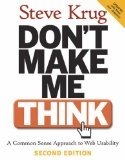
Don't Make Me Think by Steve Krug is one of the most popular Web design books ever written. It is a very good book which discusses the elements of a good Web site. It stresses the need for usability testing and provides the information in a concise and entertaining fashion.
The book is relatively short (197 pages) by design. Many of the chapters are only a few pages and I was able to read it in a couple of sittings. The material is presented using real world examples and a bit of humor. The illustrations and cartoons are very amusing and reinforce his point exceptionally well.
The major principal is of course "Don't Make Me Think", in other words your Web site should be intuitive enough that users will be able to navigate around with very little thought. Buttons and links should be noticeable, navigation should be easy to use, road maps and road signs should be prominent. Essentially the user should be able to get to the information they need with little effort and always be able to get back if they go in the wrong direction.
He dedicates almost half the book (72 of 197 pages) to navigation and the home page. Navigation is critical because you want your users to be able to find what they are looking for and even things they didn't know they were looking for. Navigation should exist on every page and remain consistent throughout your site. The homepage is the most important page on your site since almost everyone will arrive there and make a decision as to how long they will stay. The most important function of the homepage is to show the users what the Web site, and your company, does.
Steve Krug is a big believer in usability testing a point Joel Spolsky also emphasized in his User Interface Design book. User testing should be done early and often he even gives many tips on making it more affordable. Usability testing is excellent feedback for the design team since it is difficult to develop personas for Web users. Unlike applications which target a specific audience or task the Web is much more fluid. Everyone uses the Web in different ways making it much more difficult to please everyone.
One of my favorite parts of the book was the end of chapter 9 where he describes what to do with the test results. It may seem obvious but he gives a very complete outline of how to "triage" the results and get the most benefit from the tests.
Overall, I found the book very interesting and would benefit any developer. Although the book is focused on Web design many of the principals can be applied to application development. Of course I am sure I will spend the next few weeks analyzing my favorite Web sites.



No comments:
Post a Comment